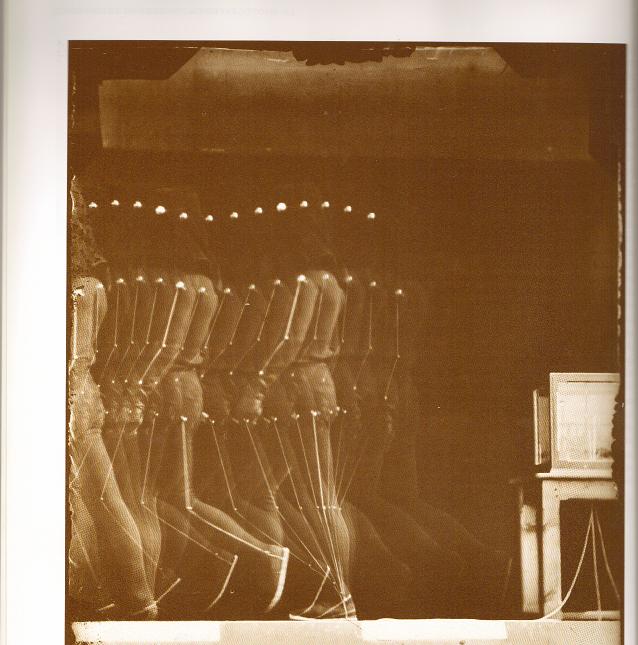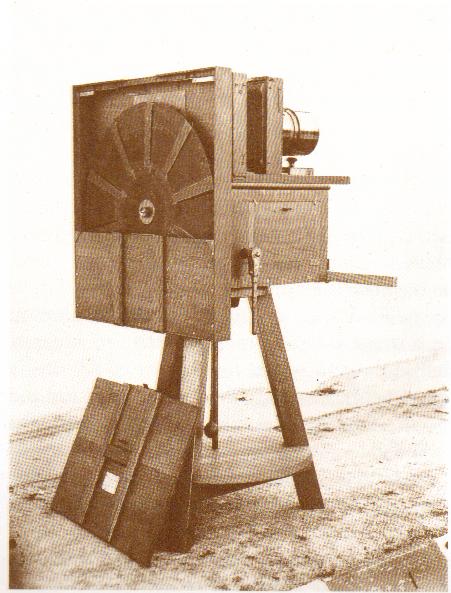[Photography] [A/H Index] [^^TIME Line]
See also: [Photography]
[Art Techniques]
[TIME LINE] (just a snap-shot of an instant of space-time glued into a plastic resin)
[Film]
[^^Film] (film index to the FILMS directory)
[post post-modernism]
On this page: {Intro}
{Concepts}
{The Usual Suspects}
{Refs}
Stop Motion
MoCap - Motion Capture got its start in 1884!
as this photograph shows:
 Entienne-Jules Marey, about 1884. A
"geometric chronophotograph" from the
original negative: College de France,
archives, Paris.
The person walking right-to-left has attached
to their side a series of lights (note the trailing
electrical cable) and the camera has captured the
"stop-motion-like" image of the person. Probably
using a rotating chopper and a multiply exposed
plate (or so it looks).
(Actually this part of the study of the techniques
used to fake the 1969 Apollo 11 Moon Landing ;)
Well, not really; Frizot, P. 242.
Marey's device:
Entienne-Jules Marey, about 1884. A
"geometric chronophotograph" from the
original negative: College de France,
archives, Paris.
The person walking right-to-left has attached
to their side a series of lights (note the trailing
electrical cable) and the camera has captured the
"stop-motion-like" image of the person. Probably
using a rotating chopper and a multiply exposed
plate (or so it looks).
(Actually this part of the study of the techniques
used to fake the 1969 Apollo 11 Moon Landing ;)
Well, not really; Frizot, P. 242.
Marey's device:
 Frizot (P. 249)
[Camera ] with a disc having 10 windows
and rotiant 10 times a second. 100 images
a second could be reached, but the level
of 10 to 20 a second was generally kept
to, with an exposure time of 1/100'th to
1/900'th of a second.
Frizot (P. 249)
[Camera ] with a disc having 10 windows
and rotiant 10 times a second. 100 images
a second could be reached, but the level
of 10 to 20 a second was generally kept
to, with an exposure time of 1/100'th to
1/900'th of a second.
 Marey's fixed-plate chrono-photography machine
with ten slit-disk acts a shutter (on the ground
is the sensitised plate holder) - large case with
a movable exposure mask; note the hand crank on
the side!
As Frizot points out (P. 249),
[This ] should not be seen as not simply a
camera, but as a the WHOLE experimental area
that Marey set up in the Bois de Boulogne -
a dark shed to provide the black background,
with which there was the area where the
subjects moved, a mobile cabin on a rail
facing the black background, electric
cables transmitting syncronised singals,
and a rapidly rotating clock placed in the
field of vision.
Or as Marey related (after viewing the amazing
possiblities of Muybridges's photographs, but
being disheartened by the cumbersomness of the
over all process,
I have a photographic gun which has nothing
murderous about it, and which takes a picture
of bird flyng or an animal running in less
than 1/500th of a second. I do not know
whether you can really imagine such a speed,
but it is something surprising. [1881]
Reference: Comptes rendus des seances de
l'Academie des Sciences,
1882.04.03, P. 15.
Marey's fixed-plate chrono-photography machine
with ten slit-disk acts a shutter (on the ground
is the sensitised plate holder) - large case with
a movable exposure mask; note the hand crank on
the side!
As Frizot points out (P. 249),
[This ] should not be seen as not simply a
camera, but as a the WHOLE experimental area
that Marey set up in the Bois de Boulogne -
a dark shed to provide the black background,
with which there was the area where the
subjects moved, a mobile cabin on a rail
facing the black background, electric
cables transmitting syncronised singals,
and a rapidly rotating clock placed in the
field of vision.
Or as Marey related (after viewing the amazing
possiblities of Muybridges's photographs, but
being disheartened by the cumbersomness of the
over all process,
I have a photographic gun which has nothing
murderous about it, and which takes a picture
of bird flyng or an animal running in less
than 1/500th of a second. I do not know
whether you can really imagine such a speed,
but it is something surprising. [1881]
Reference: Comptes rendus des seances de
l'Academie des Sciences,
1882.04.03, P. 15.
The Usual Suspects
Louis Ducos du Hauron
Cook and Bonelli
Entienne-Jules Marey
Heny Du Mont
[]
[]
[]
[]
[]
[]
-[]-
-[]-
-[]-
-[]-
-[]-
-[]-
Chronology
-[]-
-[]-
-[]-
-[]-
-[]-
-[]-
References
Frizot, Michel(1998). A New History of Photography.
Milan: kOnemann. ISBN 3.8290.1328.0, LCCN #
This massive volume is treuly a book for the
new milenium! Superbly readable, as well as
a trove of "the classics" and rare photos.
-[]-
-[]-
 Entienne-Jules Marey, about 1884. A
"geometric chronophotograph" from the
original negative: College de France,
archives, Paris.
The person walking right-to-left has attached
to their side a series of lights (note the trailing
electrical cable) and the camera has captured the
"stop-motion-like" image of the person. Probably
using a rotating chopper and a multiply exposed
plate (or so it looks).
(Actually this part of the study of the techniques
used to fake the 1969 Apollo 11 Moon Landing ;)
Well, not really; Frizot, P. 242.
Marey's device:
Entienne-Jules Marey, about 1884. A
"geometric chronophotograph" from the
original negative: College de France,
archives, Paris.
The person walking right-to-left has attached
to their side a series of lights (note the trailing
electrical cable) and the camera has captured the
"stop-motion-like" image of the person. Probably
using a rotating chopper and a multiply exposed
plate (or so it looks).
(Actually this part of the study of the techniques
used to fake the 1969 Apollo 11 Moon Landing ;)
Well, not really; Frizot, P. 242.
Marey's device:
 Frizot (P. 249)
[Camera ] with a disc having 10 windows
and rotiant 10 times a second. 100 images
a second could be reached, but the level
of 10 to 20 a second was generally kept
to, with an exposure time of 1/100'th to
1/900'th of a second.
Frizot (P. 249)
[Camera ] with a disc having 10 windows
and rotiant 10 times a second. 100 images
a second could be reached, but the level
of 10 to 20 a second was generally kept
to, with an exposure time of 1/100'th to
1/900'th of a second.
 Marey's fixed-plate chrono-photography machine
with ten slit-disk acts a shutter (on the ground
is the sensitised plate holder) - large case with
a movable exposure mask; note the hand crank on
the side!
As Frizot points out (P. 249),
[This ] should not be seen as not simply a
camera, but as a the WHOLE experimental area
that Marey set up in the Bois de Boulogne -
a dark shed to provide the black background,
with which there was the area where the
subjects moved, a mobile cabin on a rail
facing the black background, electric
cables transmitting syncronised singals,
and a rapidly rotating clock placed in the
field of vision.
Or as Marey related (after viewing the amazing
possiblities of Muybridges's photographs, but
being disheartened by the cumbersomness of the
over all process,
I have a photographic gun which has nothing
murderous about it, and which takes a picture
of bird flyng or an animal running in less
than 1/500th of a second. I do not know
whether you can really imagine such a speed,
but it is something surprising. [1881]
Reference: Comptes rendus des seances de
l'Academie des Sciences,
1882.04.03, P. 15.
Marey's fixed-plate chrono-photography machine
with ten slit-disk acts a shutter (on the ground
is the sensitised plate holder) - large case with
a movable exposure mask; note the hand crank on
the side!
As Frizot points out (P. 249),
[This ] should not be seen as not simply a
camera, but as a the WHOLE experimental area
that Marey set up in the Bois de Boulogne -
a dark shed to provide the black background,
with which there was the area where the
subjects moved, a mobile cabin on a rail
facing the black background, electric
cables transmitting syncronised singals,
and a rapidly rotating clock placed in the
field of vision.
Or as Marey related (after viewing the amazing
possiblities of Muybridges's photographs, but
being disheartened by the cumbersomness of the
over all process,
I have a photographic gun which has nothing
murderous about it, and which takes a picture
of bird flyng or an animal running in less
than 1/500th of a second. I do not know
whether you can really imagine such a speed,
but it is something surprising. [1881]
Reference: Comptes rendus des seances de
l'Academie des Sciences,
1882.04.03, P. 15.